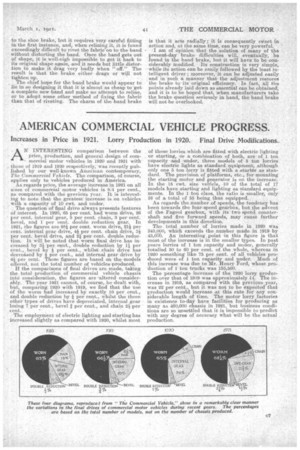AMERICAN COMMERCIAL VEHICLE PROGRESS.
Page 11

If you've noticed an error in this article please click here to report it so we can fix it.
Increases in Price in 1921. Lorry Production in 1920. Final Drive Modifications._
AN" INTERESTING comparison between the price, production, and general .design of commercial motor vehicles in 1920 and 1921 with those of 1919 and 1920 respectively, was..re:cently published by our well-known Arnorican• contemporary, The Commercial Vehicle. The comparison, of course, applies only to vehicles produced in America.
As regards price, the averageincrease in 1921 on all sizes of commercial motor vehicles is 84 per cent., as compared with the previous year. It is intere-stirtg to note that the greatest. increase is on vehicles with capacity of 10 cwt. and under.
The question of final drive always presents features of interest. In 1926, 65 per cent. had worm drive, 26 per cent, internal gear, 5 per cent: chain, 3 per cent. bevel, and I pee cent, double redaction gear. In 1921, the figures are 684 per cent, worm drive, 214 per cent. internal gear drive, 4/ per cent. -chain drive, 34 per tent. bevel drive, and 24" per cent. double reduction. It will be noted that worm final drive has increased by 84 per cent., double reduction hy 14 per eent., bevel by 4 per cent., chain drive has decreased by 4 per cent., and internal gear drive by 44 per cent. These figures are based on the ,models offered, not. the total number of vehicles produced. If the comparisons of final drives are Made, taking the total -production of commercial vehicle chassis bite consideration, the figures are -altered considerably. The year 1921 cannot, of course, be dealt with, but, comparing 1920 with 1919, we find that the use of the worm had increased by exactly 10 per cent., and double reduction by 4 per cent., whilst the three other types of drives have depreciated, internal gear losing 7, per cent., bevel 4 per cent., and chain 24 per cent.
The employment of electric lighting and starting has increased slightly as compared with 1920, whilst most
of those lorries which are fitted .with electric lighting or starting, or a, combination of both, are of 1 ton capacity and under, three models of 5 tan lorries have electric lights as standard equipment, although only one 5 ton lorry is fitted with a starter as standard. The provision of platforms, etc., for mounting the starting motor and generator is on the increase: • In the 15 cwt. size vehicle, 10 of the total of 17 models have starting and lighting as standard equipments. In the 1 ton class, the ratio is -smaller, Only 16 of a total of 55 being thues equipped.
As regards the number of speeds, the tendency has been towards the four-speed gearbox, but the advent of the. Eager)l gearbox, with its two speed countershaft and five forward speeds, may cause further developments in this direction. •
The total number of lorries made in 1920 was 848,000, which exceeds the number made in 1919 by 43,0. An interesting point in this figure is that most of the increase is in the smaller types. In past years lorries of 1 ton capacity and under, generally totalled 50 to 60 per cent, of the whole, whereas in 1920 something like 75 per cent of all vehicles produced were of 1 ton capacity and under. Much of this increase was duo toTMr. Henry Ford, whose predueti-on. of 1 ton trucks was 153,500. .
The percentage increase of the 1920 lorry production over that of 1919 was approximately 14. The increase in 1919, as compared with the previous year, was 22 per cent., but it. was not to be expe.eted that production would increase .at this rate for any considerable length of time. The motor lorry factories in existence to-clay have facilities for producing as many as 400,000 chassis in. 1921. but business conditions are so unsettled that it is impassible topredict with any degree of accuracy what will be the actual . production.
































